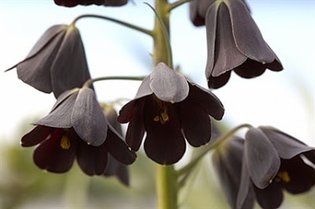 Persian Lily in the Biblical Garden Persian Lily in the Biblical Garden I went down to the nut orchard to look at the blossoms of the valley, to see whether the vines had budded, whether the pomegranates were in bloom. Song of Songs 6:11 In the Biblical Garden, the seven year old almond tree has leafed out abundantly and bloomed for the first time. The grape vine has budded in its second season on the arbor, and the dwarf pomegranate, now outdoors again, is ready to gift us with more of its tiny orange flowers and miniature fruit. The spring color-riot of early flowers continues: narcissus, brilliant blue grape hyacinth, petite red cups of wild tulips, and (new this year) elegant Persian fritillary bells in gorgeous purple, all have bloomed and faded. Iris and poppies are in full display. Now we watch for awakening of the fig tree which sleeps late each year, in the hope and expectation that it survived another winter. In May we assessed what we have gained versus what was lost or damaged due to the cold, and what to transplant, divide, and replace. We delight in “volunteers,” new plants self-seeded from last year’s ripened bounty: lupines and globe thistle, nigella and chamomile. Religious School students have been busy in the garden, cleaning up, cutting back overgrowth, and patrolling for dandelions. Seventh grade gardeners planted cucumbers, grains and lentils, and started herbs in the raised beds – this year: dill, borage, fennel, parsley. The 6th grade class secured fallen branches to the A-frame structure so the peas they have planted can climb. They have started seeds of sorghum (broom corn) which produces seed heads on stately canes 8-10 feet tall. In addition they planted chickpeas as they snacked on hummus and compared ingredients and recipes for that Middle Eastern staple. Todah rabah (many thanks) to Nate Finstein, Roxanne LaCroix, Sherry Feldman, Herb Katz, and Lily Wolfgang, along with teachers Sue Oclassen and Suanne Goodman, for helping to create another garden experience for our students. As we nurture soil, plants and community, a garden is where we might meet nature half-way, on that “middle ground between the lawn and the forest,” as author Michael Pollan observes in Second Nature. It teaches respect for, and cooperation with the natural processes that enable us to live our lives on our local patch of ground, and it encourages us to be mindful of our human place in the sacred community of life on Earth. |
AuthorsMichael Schlesinger is Temple Sinai’s Biblical Gardener. Mike has been gardening since he was eight years old. He used to grow grape vines and make wine when he lived in California. He now tends to our garden, continuing the traditions started by Catherine Walters. Archives
March 2020
|

Affiliated with the Union for Reform Judaism
30 Hagen Avenue • Cranston, RI 02920 • 401-942-8350 Office: dottie@templesinairi.org Rabbi Jeffrey Goldwasser: [email protected] |
Want to sign up for the weekly Sinai Scroll email?
Click here to receive weekly updates on Temple services, events and a message from the Rabbi. |


